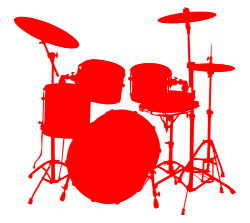Saturday I played drums on a recording session for a country singer/songwriter. This job came from a cold call or rather an email from the songwriter, who found me listed on the internet. When I asked him how he found me, he said it was on a second party site rather than my own. He said he contacted me rather than the other drummers listed because I was the only one that posted my email and phone number! Wow, the dumb mistakes people make! And I’m quite sure I have also made and continue to make really obvious mistakes at times. So anyway, maybe the first step in effective session drumming is simply make it easy for people to contact you. Then, if you get unwanted calls or emails from people trying to sell you something, just look at that as part of the price you pay for being effective in marketing your services. The point is that you don’t want to lose potential clients by hiding your contact information.
After a couple of phone conversations, the songwriter sent me YouTube links to videos of him performing acoustic versions of his songs. During one of our conversations, he said one of his biggest pet peeves was musicians saying they’d learn a song for a session or gig, and then showing up and making all kinds of excuses to why they did not in fact learn the song. I heartily agreed having worked for many years as a band leader as well as songwriter. So as you can imagine, I wasn’t about to be the guy who showed up unprepared for the session that we scheduled. I spent plenty of time listening to his songs, as well as other artist’s songs that he listed for reference.I made notes as to the structure, groove I had in mind, and jotted down anything that I thought was unclear so I could ask before he hit the record button.
On one of the songs, he wanted a hint of Latin or Caribbean style, kind of like Kenny Chesney or Jimmy Buffett. I needed to round up a conga or other hand drum so I contacted a few friends of mine, and eventually came up with a perfect instrument for the session. I prepared for the recording session, by experimenting a little with the hand drum until I came up with a groove that I thought would work well with the drum-set groove that I already had in mind for the song.
We had decided in advance that we would use the drum-set already set up in the studio for the recording session. I was just going to bring my cymbals and sticks. I went ahead a brought all my hardware, as they were already packed and in the car anyway. I personally always like to bring my own bass pedal when playing on someone else’s drum-set. I’ve run into some bad situations at times, like bass pedals that were so tight that I could barely play them.
The engineer had decided to use triggers to record the drums. I’d never done this before, but I thought it worked just fine. It saved me the trouble of having to bring all my own drums, set them up, tune them, wait for the engineer to get all the mics placed, and then have to tear the whole thing down at the end.
Once we had the cymbals in place and did a sound check we were ready to go. None of the musicians had ever played together before, and I’d never met the bass player. I wasn’t sure how well everything was going to work. We started off by just playing through the tunes. It was obvious immediately that this was probably going to be an easy session. The players had all done their homework and knew the songs. They were also all very good players, with a great sense of taste and excellent time and feel. In addition, there were no ego problems. We worked well as a team, making suggestions, but not insisting on having our way.
I started off with a groove on each song that I thought would work. I tried not to deviate too much from that initially, because I knew that the bass player was listening to me to see what I was going to play, so he could decide what he should play on the bass to compliment my playing. I figured if I constantly changed, he wouldn’t know what to play.
As we played through the songs several times, I tried to self-evaluate what was working as far as my playing and what wasn’t. I also asked the musician’s opinions. I asked them things like, “Do you like the fact I switched from high-hats to the ride cymbal in certain parts of that song, or does the ride cymbal seem out of place there?” I asked the songwriter if he liked my funky 2-handed sixteenth groove on one of his country songs. He said it sounded like modern country, and said it was perfect.
It took longer in the studio than we’d anticipated. Anyone who’s ever been in a recording studio will tell you that this is almost always the case. I remained flexible and kept a positive attitude. When the session was over I got an email from the songwriter saying how much he appreciated not only my session drumming, but also my professional attitude and way of doing business.
